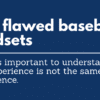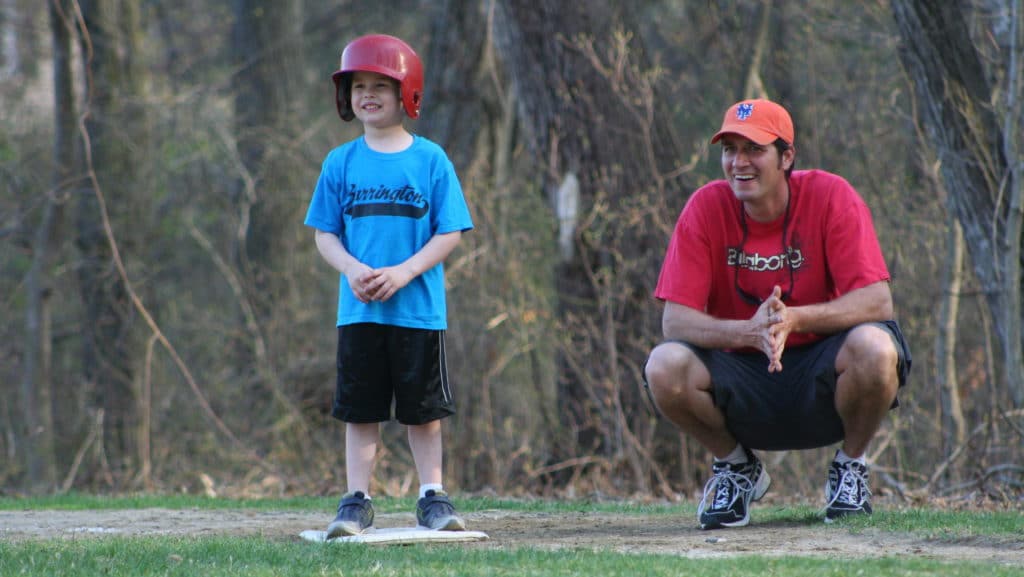As an adolescent living in baseball-poor Northern Michigan in the early and mid 1990s, I was desperate to learn how to increase my velocity and become a better pitcher. Throughout Little League, I was a dominant force on the mound, striking out about two thirds of the batters I faced. But my success was largely due to one factor: I was tall for my age and capable of powering hard, straight fastballs past my peers.
I had no idea what I was doing on the mound. I tried to mimic the mechanics of Detroit Tigers pitcher Bill Gullickson, who was in the midst of a 20-win season when I started pitching in 1991. Everything else I learned from my dad, who had no formal organized baseball experience beyond Little League. Then, when I was 10, I attended one week of baseball camp at Eastern Michigan University. That was the full extent of my coaching up until the age of 12.
You know how this story goes. By the age of 13 or 14, other kids had started to catch up. I wasn’t the tallest anymore, and with my skinny frame I sure wasn’t the strongest. I couldn’t do a single push-up or pull-up. I was still usually the hardest thrower on any given team, but the gap between me and everyone else was closing. And I started to realize I was falling behind in other areas; my control was mediocre and my only secondary pitch was a lackluster circle changeup with virtually no movement. To top it all off, my family moved from Michigan to Englewood, Florida, where kids had been playing year-round organized ball since the age of six or seven.
Those were the early days of the World Wide Web, and also the early days of the baseball instruction boom. Not surprisingly, a niche market that focused on player improvement began to develop just as pro players started making increasingly insane amounts of money—and right at the moment when ultra-competitive travel ball exploded onto the scene.
It was a time of immense change. Advances in technology were rapidly altering the game and its players, who were getting bigger, stronger, and faster. The era of the everyman ballplayer—of guys with idiosyncratic mechanics and un-athletic bodies (see inset, right)—was drawing to a close. Every stage of the baseball environment became more competitive and players, parents, and coaches were starving for information that would help them get a leg up on the competition.
It was 1997 or 1998, right around my first year of high school ball, and two things happened: First, I went to the local public library, found an internet-connected computer, went on the Web, and somehow signed myself up for the mailing list of a pitching guru and former MLBer named Dick Mills. Second, one of my new Florida coaches suggested I read The Art and Science of Pitching by Tom House.
Shortly thereafter, I started receiving pamphlets in the mail from Dick Mills. His “newsletters”—which were breathless 11 or 12-page double-sided manifestos about revolutions in pitching—looked exactly like every internet marketing writeup you can find right now on the website of just about any baseball coach who has a product or service to sell (or any other “coach” or “consultant” or “expert” that wants to sell you their e-book or program).
Mills’ newsletters contained little tidbits of information; bold promises that made you anxious to learn the rest of his revolutionary system. These newsletters were designed to make you think that Mills—through some combination of his experience and research—had unlocked a secret formula, and all you had to do was buy a subscription, or a book, or whatever, and you’d be able to dramatically increase your velocity and unleash your full potential.
The main points outlined in Mills’ newsletter, as best as I can recall, were:
- Pitchers should be careful not to take too long of a stride.
- Pitchers should “pull” off the rubber rather than push off it.
- Pitchers shouldn’t lift heavy weights or use weighted balls.
Here’s Mills in his own words, referring to a book he wrote in 2006:
This is one massive book that is unlike all previously written books on baseball pitching, which are simply the unsubstantiated beliefs of the authors. This is a fully researched “evidence-based” book – the first in baseball history.
It may be the only book on pitching that does not endorse pitching drills, weight lifting for more strength, stretching prior to pitching or throwing, long toss for more velocity, less-than-full distance or less-than-game intensity bullpens, flat ground throwing and, of course, the use of weighted baseballs.
Was Mills right? Who knows—my family couldn’t afford whatever he was selling, though I tried to glean as much as I could from the newsletters.
Tom House’s book had a completely different perspective. The core argument in The Art and Science of Pitching was a concept called tall and fall; House essentially argued that pitchers should seek the longest possible stride to the plate—the opposite of what Mills argued. House’s book relied on biomechanical modeling and human kinetics, and featured stick-figure illustrations of bodies in various stages of delivery.
It was visually impressive and highly influential. Aside from the science House included in his book, he leaned on his experience working with Nolan Ryan in the Rangers’ organization as a source of credibility. Like Mills, House argued that the information he had published was revolutionary.
Was House right? Who knows—I read the book but was never able to fully grasp or implement its concepts. As a 14 or 15-year-old kid reading that book in my room, I had no idea how to translate the information on those pages into an actionable training program. To the extent that I tried, my efforts conflicted with whatever my coach-of-the-moment was teaching.
As I progressed through the next four years of baseball, I played on dozens of teams and had dozens of coaches. Aside from Mills and House, it seemed like every new coach taught something different, or had different priorities, or saw different problems with my delivery. I could go to practice on Monday and have a former pro player-turned-coach tell me to stay tall, and on Tuesday have another former pro player-turned-coach tell me bend my knee and drop-and-drive to the plate.
I had no idea what was right, and I was never completely sure what I was supposed to be working on. Anything I chose to do in the bullpen or the weight room contradicted one of my coaches or ran counter to what I was reading from one of the gurus. And I had no capacity to judge whose information was right, or whose program to trust and commit to. So, in the end, my mechanics were some vague combination of pieces from every system or program I’d read about or been taught.
Still, I have to say, it was Mills who influenced me the most. His promises were enticing and his reasoning made sense to my teenage brain. He wrote about how too much weightlifting slowed down your fast-twitch muscles, so I only worked out with dumbbells. He wrote about how pushing off the rubber causes your arm to lag behind your body, so I stopped focusing on engaging my lower half (but particularly my post leg). I took what he wrote seriously. After all, he was an expert who had done research! His book contained “over 500 scientific references!”
But, of course, I never got stronger and I never got better. I suspect that Mr. Mills (who recently passed away) would say that someone like me needed to fully commit to his program—to buy whatever it was he was selling, instead of just trying to work from the bits and pieces he doled out for free. Maybe that’s right, but I doubt it. Because honestly, I think Mills was full of baloney from the beginning.
I think Tom House is slightly less full of baloney. Certainly, House’s reputation and resume is vastly superior to Mills’; aside from his independent coaching and writing, he served as the volunteer pitching coach for USC (his alma matter) from 2008 to 2011 and has a group of dedicated followers. He’s worked with a host of high-profile pitchers. But there are troubling similarities between these two individuals as they relate to the state of baseball coaching and instruction today.
Dick Mills was running a confidence game. His marketing materials referenced and alluded to science, but his real talent wasn’t research—it was his ability to get kids and their parents excited enough about the possibility of unlocking their full potential to hand over hundreds of dollars for books and videos and private consultation. He profited off the hopes and dreams and gullibility of people who demanded little or no proof that anything contained in those newsletters was backed by even a smidgen of credible evidence. And he probably spoiled the potential of more than a handful of young ballplayers along the way.
Likewise, in The Art and Science of Pitching, House makes numerous claims that he supports primarily by citing his own proprietary research. However, this research was never published in peer-reviewed academic journals and has never been fully available in print or online. It cannot be examined for methodological problems, has not been subject to the criticism of scholars, and cannot be replicated. Since it cannot be replicated, it cannot be verified. This is true of the vast majority (if not the full body) of the research he has conducted since the 1980s.
In addition to that, while House tends to go lighter on the hyperbole and hard-sell than Mills, he has a troubling record of employing ethically-dubious marketing tactics:
- House is the founder of the misleadingly-titled National Pitching Association. Obviously, its name alludes to professional governance and oversight organizations such as the National Association of Realtors, which—among other functions—sets and enforces ethical standards and provides professional certification. However, the NPA is actually just a private umbrella organization that sells products and services through a network of affiliated providers (i.e. private coaches) who are trading off the Tom House brand.
- Here’s one example of how House uses the NPA to mislead potential customers: In the promotional blurb for the revised 2006 edition of The Art and Science of Pitching, House writes that the book was “produced in cooperation with the National Pitching Association.” That, of course, suggests that the book has the backing, participation, and endorsement of a well-respected professional organization.
- House uses the title “Dr.,” and even stars in a promotional video titled “The Throwing Doctor.” But Tom House is not a throwing doctor. His Ph.D. is in sports psychology and is totally unrelated to pitching mechanics or kinetics. House has no formal academic training in any field related to human movement, physical science, or human nutrition.
- Additionally, House earned his Ph.D. from what is now known as Alliant University, a private, unranked institution with a dubious reputation for low academic standards and poor post-graduation match rates. His dissertation is not available for review; the Alliant library does not have a copy or record of it, and the Registrar’s Office refused to confirm or deny whether it has a copy on file, or whether House was even required to produce one as part of his program.
- House claims to be the founder of the “Rod Dedeaux Research For Baseball Institute,” which is housed in a training facility built at USC while he was the pitching coach there. However, it’s not clear what research (if any) has taken place at this facility, as none is available online or in print journals. It’s not clear if the “institute” is even active; it does not have a website and has not published a Facebook update since 2012. An employee of the USC athletic department told me that Institute is not affiliated with the school.
House uses exaggerations and misrepresentations to bolster his credibility and support his commercial activities. Like Mills, House works hard to convince people that he is an expert with a long list of credentials who possesses unique, proprietary information—and that access to that information is worth giving him their money.
And maybe it is. Aside from the ethical concerns outlined here, one thing was and remains true: Dick Mills and Tom House might be right about pitching. Either of them might be completely, 100% correct. Absolutely, it’s possible.
But It’s also possible that they are completely, 100% wrong. It’s possible that their products and information have neutral or negative impacts on player development. It’s possible that when you give them your money for a book, or a DVD, or a training product, or a camp, you’re not only flushing your money down the drain but also suffering the opportunity cost of spending time and energy working on the wrong things.
The problem is that there’s absolutely no way to know. And by the time you figure it out, if you’re wrong? It’s probably too late. If you’re a 14-year-old kid trying to increase your velocity because you want to play college or pro ball, you don’t have a couple of years to train under the wrong program, learning and practicing the wrong things.
Today, there are countless gurus and instructors actively peddling their services and products online, including information, training gadgets, and private lessons. Many of these coaches have massive followings on social media and popular YouTube channels. These coaches communicate directly with kids and families, and significantly influence the thinking of lower and mid-level coaches around the globe.
And they make enticing claims: They’ll teach you the secrets of unlocking your maximum velocity, or they’ll teach you how to consistently hit bombs even if you’re a little guy. They all claim to know what you need to do to get better, or to have some tool or technique to help you do so. And they all tell you to follow your dreams, to believe you can make it—all you have to do is work hard and spend a little bit of money—don’t worry, it’ll be worth it when you get that scholarship or make it to the Bigs.
I don’t know how much money American families spend on stuff like this every year, but it’s a lot. And almost every one of those purchases is aspirational. Families hand over money based on the hope that their investment will have a positive result. That hope is built through a marketing processes in which coaches try to make players and parents believe that their product or service is valuable. But the harsh reality is that in virtually every case there is little or no credible evidence backing the claims. If you don’t believe me, just ask to see the data. Most of the time, it simply does not exist.
The result is that people end up paying hundreds or thousands of dollars for information and products that have not been thoroughly tested and vetted, essentially gambling away their limited resources. The cost of playing competitive baseball is already prohibitively high for many poor players, minority players, and players from rural areas—between increasingly expensive and specialized equipment and the costs associated with traveling to tournaments, camps, and showcases, families can easily spend the equivalent of a year’s college tuition over the course of a single season. Should those families choose to spend even more to access specialized information, they deserve some degree of certainty that they’re not buying junk.
The hunger for information—and the desire of so many coaches to capitalize and profit from that hunger—highlights a problem that the baseball coaching community has so far refused to face. Like me at the age of 14, the overwhelming majority of young baseball players are poorly coached. They are taught bad (and often contradictory) information, and they suffer because of it—sometimes they get injured, but more often than not they just stop getting better, get bored, and quit.
That’s a failure that rests squarely on our shoulders, because we have failed to develop a sufficiently meaningful body of knowledge about our sport. We have few or no established “norms,” which means we in turn have no development standards, no benchmarks, and no best practices. And because we have none of these, we have no way to hold bad actors accountable when they sell information that’s based on flawed, inconclusive, or nonexistent research.
Ask ten coaches at any level about the fundamentals of hitting, throwing, or running, and I guarantee you’ll get a variety of answers. But how could it possibly be true that after over a century and half of playing baseball we cannot conclusively and uniformly answer the simplest of questions about the most basic techniques? How could it be that we have no standard models for teaching core skills?
Ask those same ten coaches how sure they are of their answers, and I bet almost all of them will tell you that they’re just completely certain. But then ask them how they know.
Or, ask yourself, right now, how you know what you think you know about baseball. Where does that knowledge come from?
Almost nothing that baseball coaches teach has been measured or tested. Almost no question that you can ask can be answered based on sound empirical observation. Almost no product you can buy has been demonstrated to have a positive impact on development or performance. From the most basic to the most complex questions, the overwhelming majority of baseball coaches—including those who charge money for their opinions—are teaching things that come from either their past personal experience in the game or from proprietary research that you cannot examine.
Failing to demand rigorous research prior to accepting the validity of an idea prevents us from creating a hierarchy of information that builds consensus, and that lack of consensus about what to teach and how to teach it makes all players potentially vulnerable to shady marketing, low-quality information, and gimmicky, waste-of-money products. That lack of consensus also prevents us from developing systems and strategies that can help more players improve and get on track to advance through the different stages of the game.
We as a coaching community should be able to tell any 14-year-old kid what is generally accepted as the “right” way to pitch; we should be able to, without much debate, identify what his or her strengths and weaknesses are based on an accepted and widely-recognized framework, and then provide that kid with clear, consice steps to improve. This information should be completely free, easily accessible, and entirely based on data that can be reviewed and criticized—never on opinion, anecdote, or casual inference.
That’s why I’m an advocate for standard models of mechanics and training. That doesn’t mean every player has to (or should) do the exact same movements, or have the exact same mechanics. It means that we should all start with the same foundational understandings about what typically works best and why, and about how to teach those things effectively. It means that while our opinions may be different about the relative merits of certain techniques, we are all working from the same pool of facts (which are derived from quality research). Only once we establish standard models can we effectively work with variations to those model—people who, for whatever reason, benefit from pitching or hitting a different way.
And that’s an important point: In time, and with more research, it will be possible to greatly expand the standard model—to say, for example, that while players with Body Type A respond best to Training Style X, players with Body Type B respond best to Training Style Y. Such a model allows us to provide the right instruction to the right players at each stage of development.
Players should be taught using the collected best judgement of the entire baseball coaching and human performance communities, not based off the opinions of a single coach—even one who has played at the highest level.
Of course, most kids aren’t taught by ex-MLBers anyway. The reality is that most youth baseball coaches are volunteer parents who, while to be praised and commended for their service to their kids and communities, don’t have a sufficient background in science or baseball to distinguish good information from bad information. And because of that reality, it falls on those of us for whom this is more than a hobby to create standards and norms for how we process, reject, and ultimately codify and canonize ideas.
Because any player who wants to work hard to become a better baseball player should have free access to the best information available at the time. But also because in order to grow the game we have to make it inclusive and dynamic and fun for everyone who steps onto the field, no matter where they live or how much money they have.
That means we have to make sure that players who are trying to advance to college or the pros don’t get stymied along the way by compelling internet marketing. But it also means we need to begin to coalese around core teaching programs and techniques that can be refined and replicated so that we raise up the level of play at the bottom end of the spectrum, too.







